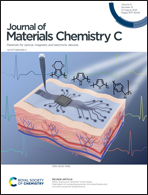An organic synaptic transistor with integration of memory and neuromorphic computing†
Abstract
Artificial synapse devices have received great interest in recent years for attempting to emulate brain-like computing systems and to conquer the bottleneck of the Von Neumann system. However, integration of the memory and computing function in a single device is a huge challenge because the synaptic behavior in computing inevitably changes its memory state, while in-memory computing has become an effective way to achieve high bandwidth, low power consumption and computing requirements. Here, we demonstrate an artificial synaptic device with integration of memory and neuromorphic computing based on a field-effect transistor (FET) with a blend structure of black phosphorus quantum dots (BPQDs) and organic semiconductors. Benefiting from the switching between the two capture mechanisms, the transistor exhibits two obviously different memory states decided by the amplitude of single impulse, along with controllable adjustment of synaptic behavior while maintaining each memory state. For further describing the ability for in-memory computing, we also demonstrate the potential application of our device in pattern recognition and distributed memory with parallel computing in brain-like computing. This work provides a path toward in-memory computing applications based on transistors for future artificial brain-like computing electronics.

- This article is part of the themed collection: Quantum computing and quantum information storage: Celebrating the 2022 Nobel Prize in Physics


 Please wait while we load your content...
Please wait while we load your content...